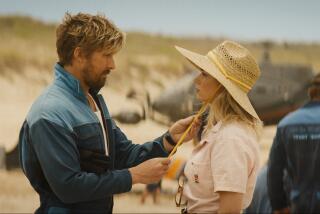One Stunt They’ve Been Unable to Pull Off
Jack Gill was standing on the street in his police officer blues, his eyes obscured by mirrored sunglasses. He was taking a lunch break from pursuing the actor Jack Black around the Long Beach waterfront, a popular location for staging chase scenes for at least half a century.
Gill was explaining why he sometimes feels that his personal campaign to get the Academy of Motion Picture Arts and Sciences to recognize movie stunt coordinators with an Oscar category has been going on almost as long.
“I just don’t get it,” he told me. “Unless they just have a grudge against us.”
Gill, 49, has been pressing his case for 15 years, writing letters to academy officers, lining up support among prominent directors, producers, and action stars, even staging a street demonstration outside academy headquarters earlier this year. He probably came closest to success in June, when the question came before the academy board of governors. They voted it down, provoking a statement of dismay from, among others, Gov. Arnold Schwarzenegger, who urged the academy to reconsider. Gill says he hasn’t even received a reply to his letter appealing the vote.
Academy officials say a stunt coordination category would only contribute to an award glut and further bloat the Oscar telecast. A new category “must have a compelling case,” says Bruce Davis, the academy’s executive director. “Clearly this didn’t rise to that level.”
Gill became a stunt performer in 1976, after a stint as a motocross racer. After winning a race in Florida he ran into the action director Hal Needham, who suggested he come west and put him in touch with Stunts Unlimited, one of the leading stunt organizations in Hollywood. Since then Gill has performed or coordinated stunts for more than 100 features and TV series, including “Knight Rider,” The Cat in the Hat,” and the recently-released “Must Love Dogs.”
Gill argues that, if anything, the job of stunt coordinator has gotten more important and technical over the years. The pyrotechnics are more elaborate and the stunts trickier as producers and directors play “can you top this?” Computer generated imaging can accomplish some of what used to require live stunt performers, but when CGI reaches its limits, human beings still have to flip the cars, fall from skyscrapers and stagger up the street engulfed in flames, all at great risk to their health and safety.
Choreographing and managing this work is “a technical and an artistic job,” Gill says, naming the qualities ostensibly celebrated by Oscar statuettes. He’s seconded by officers of the Screen Actors Guild, to which stunt performers generally belong. “Stunt coordinators will often take over directing,” says Melissa Gilbert, who is closing out her term as SAG president. “They place the cameras, the assistant directors answer to them. They’re making a movie within a movie.”
SAG is considering adding a stunt category to its own annual awards, although that wouldn’t happen before 2006. The Academy of Television Arts and Sciences has already fallen into line, having awarded a stunt-coordinator Emmy beginning in 2002. Stunt performers also stage their own annual awards show, handing out “Taurus” awards, sponsored by the distributor of an energy drink, in categories that include “Best Aerial Work” and “Best Fire Stunt.”
There’s nothing sacrosanct about the current roster of Oscar categories. The motion picture academy changes the lineup regularly. The award for best animated feature is only 4 years old, added after a decade of discussions that turned on the issue of whether there would be enough candidates each year to keep it from becoming the Pixar Oscar by default. (As it happens, two of the four awarded thus far have gone to Pixar features.)
Other categories have been added, dropped, or tweaked over the years. An Oscar for “dance direction” was awarded three times in the 1930s, arguably the heyday of big production numbers. “Special effects” morphed into “special visual effects” in 1963, when the optical effects exemplified by “The
Longest Day” and “Cleopatra” began yielding to the greater technological sophistication of “2001: A Space Odyssey” and, eventually, “The Lord of the Rings.”
Davis observes that the academy has fought a long battle to keep the length of the awards show under control, but considering that the record holder (2002) clocked in at nearly 4 1/2 hours, adding or subtracting a single category doesn’t sound like the key to getting East Coast viewers to bed before midnight. Gill notes that one recent Oscar telecast opened with a montage that included numerous stunts; the only thing missing was a mention of the craft. Indeed, the only time the Oscars ever formally recognized stunt work was with a special award in 1996 to Yakima Canutt, the stunt man famed for staging such sequences as the chariot race in “Ben-Hur.”
It’s hardly surprising that Gill senses a subtle prejudice against his craft coming from academy officials. Indeed, one can hear stunt coordinators dismissed as “second unit directors” (a title under which they are sometimes listed in a movie’s credits), as though once they’re admitted to the Oscars, there will be a clamor for awards for crowd shots and landscape pans.
In the wake of this year’s rejection, Gill says he’s at a loss for a new strategy. He counts off the Hollywood luminaries who have signed his petitions and rallied to his cause -- Martin Scorsese, Steven Spielberg, Keanu Reeves, Jerry Bruckheimer, among them. Many of these people understand that without stunt coordinators and performers, whole genres of Hollywood features wouldn’t exist. But try telling that to the Oscars.
Golden State appears every Monday and Thursday. You can reach Michael Hiltzik at [email protected] and read his previous columns at latimes.com/hiltzik.
More to Read
Only good movies
Get the Indie Focus newsletter, Mark Olsen's weekly guide to the world of cinema.
You may occasionally receive promotional content from the Los Angeles Times.











